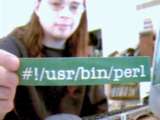|
Here's the list, in alphabetical order.
Aqua is of course based on
Mac OS X.
This new version of the Aqua theme is specifically derived
from Mac OS X 10.3 Panther, which I find less annoying than previous
incarnations. On my site, this theme is created with transparent
alpha-channel PNGs, which may not work in some browsers
(*cough* Internet Explorer *cough*).
The Be theme is based on the
discontinued BeOS. If you liked the BeOS, the
OpenBeOS project may
interest you.
The Bluecurve is
RedHat's Gnome-based
desktop. I've heard a lot of bad things about RedHat, and there's no
way I'd put it on a server, but for a desktop system, I'm actually
pretty impressed. If you're not a “power user”, and the
included apps do what you need, I don't see why any Windows user
couldn't make the switch pretty easily.
Chicago was the
code-name for Windows 95 (which was originally to be called Windows
4.0, and released in the first half of 1994).
Classic is based on the
second major revision of this site, circa 1999.
E
is based on a theme for the Enlightenment window manager that I found at
e.themes.org, with a background from
digitalblasphemy.
The new version of this theme uses a transparent PNG; previously I had
used a dithered transparent GIF.
Hi-Tech is a theme that
Apple developed for Mac OS 8.5, but did not include in the final
shipping version. I suppose only Steve Jobs will ever know why
that decision was made. I've tried to make a Gizmo theme as well,
but it's rather complicated, and I gave up on it.
Luna is the default theme
for Windows XP. It's even worse than Aqua used to be.
The NeXT theme is based on
OpenStep (originally called NeXTStep). Apple bought the company
and used OpenStep as the basis for Mac OS X. A lot has changed,
but there's a lot of stuff in Mac OS X that an OpenStep user will
recognize. WindowMaker is a window manager for X based on OpenStep.
Plain is derived from
Platinum, but greatly simplified with a lot of the graphics removed.
This was originally the default theme for Netscape 3, because it didn't use
background graphics in tables, which Netscape 3 doesn't support.
Since I now use CSS extensively, which Netscape 3 doesn't support
either, there's not much point anymore. I may remove this theme someday.
Platinum is the main theme
I used to design this layout. Many of the other themes were derived
from Platinum, with replaced graphics and slight code changes.
Platinum is the theme Apple developed originally for the
failed Copland project and then released with Mac OS 8 in 1997.
System Seven is what the
Mac OS looked like prior to Mac OS 8.
The Simple theme, as I've
already mentioned, is designed for old or limited browsers such as
Netscape 2 and Lynx. It works with anything, and vaguely resembles
the original version of this site. I chose this color scheme because
Netscape 2 for Windows only supported 16 colors of text, and that's
what most people were using at the time, so I chose text and link
colors from the Windows 16-color palette.
The Slashdot theme is
modeled to look like Slashdot, a
computer-related news site. A few people have asked why it says
“blah blah blah” along the side, it's just there for the
look. If you have ideas on how I should improve this theme, let me
know.
I threw together the Terminal
theme in a couple minutes just to show an old coworker how easily I
could create new themes.
Watercolor was the theme
used in early versions of Windows XP (code-named Whistler). Microsoft
chose not to ship the theme with XP (mimicking Apple AGAIN), but
WindowBlinds and
Trillian both have
Watercolor themes available.
Many of the backgrounds are included with Mac
OS 9. The Classic background I drew in Aldus SuperPaint.
If you have an idea for an original theme you'd like
to see (not all themes have to look like windows on a desktop!) let me know,
and if you're running a system that I haven't represented here feel free
to send me screen shots (preferably PNG or zipped/stuffed PICT or BMP, rather
than a lossy format like JPEG).
|










 Home
Home Weblog Archive
Weblog Archive About Me
About Me Fish Banner
Fish Banner Cannons and Castles
Cannons and Castles Tic-Tac-Toe
Tic-Tac-Toe Articles
Articles Fighting Back
Fighting Back Macintosh
Macintosh